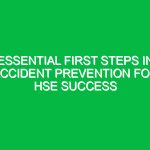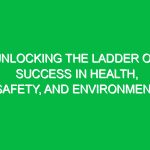Introduction
Good morning, team! Today, we are conducting a toolbox talk focused on an essential topic in the Health, Safety, and Environment (HSE) domain: the Line of Fire. Understanding the concept of the Line of Fire is crucial for ensuring our Safety on the job. This discussion will not only highlight what the Line of Fire entails but also provide practical insights on how to identify and manage risks associated with it. Let’s dive into the details.
What is the Line of Fire?
The term Line of Fire refers to any situation where a worker is exposed to the potential for injury from moving objects, falling tools, or hazardous materials. This can occur in various environments, such as construction sites, warehouses, and manufacturing plants. Essentially, if you are in the path of something that could cause harm, you are in the Line of Fire.
The Importance of Understanding the Line of Fire
Recognizing the Line of Fire is critical for several reasons:
- Prevention of Accidents: By being aware of our surroundings and potential Hazards, we can prevent injuries.
- Promoting Safety Culture: A team that understands safety practices fosters a culture of care and concern for each other.
- Compliance with Regulations: Understanding the Line of Fire is not just best practice; it’s often a regulatory requirement that helps us remain compliant with safety laws.
Key Components of the Line of Fire
To effectively manage the risks associated with the Line of Fire, we need to understand its key components. These include:
1. Awareness
Always be aware of your surroundings. Know where the potential Hazards are and how they can affect you and your coworkers. This means paying attention not only to your work area but also to the actions of those around you.
2. Communication
Communicate openly with your team. If you notice someone is in the Line of Fire or if you are about to perform a task that could put someone at risk, speak up. Clear communication can often prevent accidents.
3. Training
Participate in regular safety Training that includes specific instruction on avoiding the Line of Fire. The more prepared you are, the better you’ll be at identifying and mitigating hazards.
4. Personal Protective Equipment (PPE)
Always wear the appropriate PPE for your job. This could include hard hats, safety glasses, gloves, and steel-toed boots, depending on the risks present in your work environment. PPE acts as the last line of defense against injuries.
Identifying Hazards in the Line of Fire
Let’s talk about how to identify potential hazards that could place you in the Line of Fire. Common scenarios include:
- Moving Equipment: Be mindful of forklifts, trucks, and other machinery that could pose a risk.
- Falling Objects: Tools or materials dropped from height can be deadly. Always use tool lanyards and ensure materials are secured.
- Electrical Hazards: Exposed wires or faulty equipment can create sparks or electrical arcs.
- Hazardous Materials: Chemicals or other substances that may spill or create a hazard if not handled properly.
Real-Life Examples
Let’s consider a couple of real-life examples to illustrate the importance of being aware of the Line of Fire.
Example 1: Construction Site
Imagine a construction site where workers are using a crane to lift heavy materials. If one worker stands directly beneath the load, they are in the Line of Fire. A sudden failure of the hoist or a miscommunication can lead to severe injury or even fatality. Awareness and communication are vital in this situation to ensure no one is positioned in harm’s way.
Example 2: Warehouse Operations
In a warehouse, a worker is operating a forklift to move pallets. If another employee is walking in an area where the forklift is maneuvering, they are in the Line of Fire. Proper training, signage, and the use of safety barriers can help prevent such incidents.
Best Practices for Avoiding the Line of Fire
Now that we have a grasp of what the Line of Fire is and how to identify hazards, let’s look at some Best Practices to avoid putting ourselves and others at risk:
1. Conduct Risk Assessments
Before starting any task, conduct a risk assessment to identify potential hazards and develop a plan to mitigate them. This should be a routine part of your job.
2. Establish Safe Zones
Designate safe zones where workers can stand while machinery is in Operation. Mark these areas clearly and ensure everyone on site is aware of them.
3. Utilize Spotters
When operating machinery, consider using a spotter to help manage the area and alert you to potential dangers. This person can provide an additional layer of safety.
4. Implement Lockout/Tagout Procedures
Ensure that all equipment is properly locked out and tagged to prevent accidental operation while Maintenance or repair work is being conducted. This is crucial in preventing injuries related to the Line of Fire.
Regulations and Standards
Understanding the regulations surrounding the Line of Fire is essential for compliance and safety. OSHA (Occupational Safety and Health Administration) provides guidelines that require employers to maintain a safe working environment by identifying and mitigating risks associated with the Line of Fire.
Always be aware of your company’s safety policies as well. These policies are designed to protect you and your coworkers. Compliance with these regulations not only promotes safety but also helps avoid legal repercussions for the company.
Open Discussion
Now that we’ve covered a lot of ground, I would like to open the floor for discussion. What are some of the hazards you’ve encountered in your work environment that relate to the Line of Fire? How did you address them? Your experiences can help others enhance their awareness and safety practices.
Conclusion
In closing, understanding the Line of Fire is essential for maintaining a safe working environment. By being aware of our surroundings, communicating effectively, utilizing PPE, and following Best Practices, we can significantly reduce the risks associated with our daily operations. Thank you for your attention and your commitment to safety. Let’s continue to look out for each other and ensure that everyone goes home safe at the end of the day.


